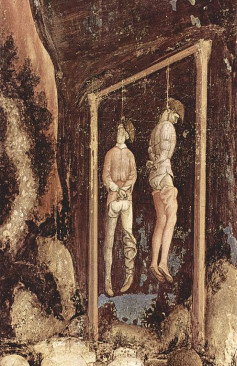History of Capital Punishment
By Ben Darlow
Published on May 18, 2014

The legal history of capital punishment in the United Kingdom is an interesting one and ranges across many centuries from the extreme of having no crimes strictly punishable by death to a multitude and back to none. In early Norman times, the principles of the common law in relation to the punishment of crimes were very simple. If the crime was a misdemeanor (minor or petty offences) then the punishment was at the discretion of the justices of the court.
For felonies (serious offences) the criminal was put on the king’s mercy which usually involved the ordering of mutilation in the form of castration or blinding. This was seen as a mercy rather than imposing the ultimate punishment of death.
By the early 13th Century, a fixed penalty of death was imposed for almost all felonies. For treason, this was death by being hung, drawn and quartered and for other felonies, simply death by hanging. This fixed penalty was grossly inflexible and various methods were used to mitigate the sentence of death, until later reforms abolished it. These methods included Sanctuary (my post on which can be found here), Benefit of Clergy, Pardons and Jury Mitigation.
This state of affairs continued for some time. The expertise of the legal profession was directed towards thinking of incredible ways to avoid the death penalty, rather than reform it. Still by 1688 there were 50 offences within statute law that carried a death sentence, this rose to 220 by the the late 18th Century. These offences were wide-ranging and even included being in the company of gypsies for one month. It is a testament to the above mentioned methods of avoidance that, between 1770 and 1830, 35,000 death sentences were given but only 7,000 people were executed.
The legal reformer Sir Samuel Romilly KC, also responsible for calling for the abolition of slavery, succeeded in having the death penalty abolished from a mere two offences, namely pick-pocketing and stealing from bleaching grounds.
A year after Sir Romilly’s death in 1818, a Parliamentary select committee looking at the issue of the death penalty led to several statutes that slowly, and in a piecemeal fashion, abolished the death penalty from many offences.
By the 1860s, there were only several offences that still attracted the death penalty. These were murder, treason, piracy, and arson in naval dockyards. This remained the same until 1957 when difficult cases arose as regards capital punishment for murder. It led to the introduction of the Homicide Act 1957 which suspended the practice and the Murder (Abolition of Death Penalty) Act 1965 which abolished it entirely. Death as a punishment for Arson in naval dockyards was repealed by the Criminal Damage Act 1971.
Although beheading was removed as a potential punishment for treason in 1973, hanging remained until 1998 when the Crime and Disorder Act 1998 abolished some of the last remnants of capital punishment in the UK, with the abolition of the punishment for treason and piracy.
The last remnant of the death penalty in the UK (the punishment existed within military jurisdiction during wartime) was abolished by the coming into force of the Human Rights Act 1998. Since 2004, the UK has been signed up to the 13th Protocol of the European Convention on Human Rights which prohibits the death penalty in any circumstances. It would be impossible for the UK to bring in laws to reinstate the death penalty unless they were to formally withdraw from the Convention.
The Author

Ben Darlow is the author of the English Legal History blog and has an LLB (Hons) Law degree from the UK’s University of Leicester.
He has always had a healthy academic interest in, and fascination with, Legal History and established the English Legal History blog in April 2013 to bring that interest to a wider audience in an easy-to-digest and accessible format.
Article picture: Two Hanged Men by Pisanello. Source: Wikipedia. Picture no. 2: Auernführer Jäcklein Rohrbach wird 1525 in Neckargartach bei lebendigem Leib verbrannt. Source: Wikipedia


